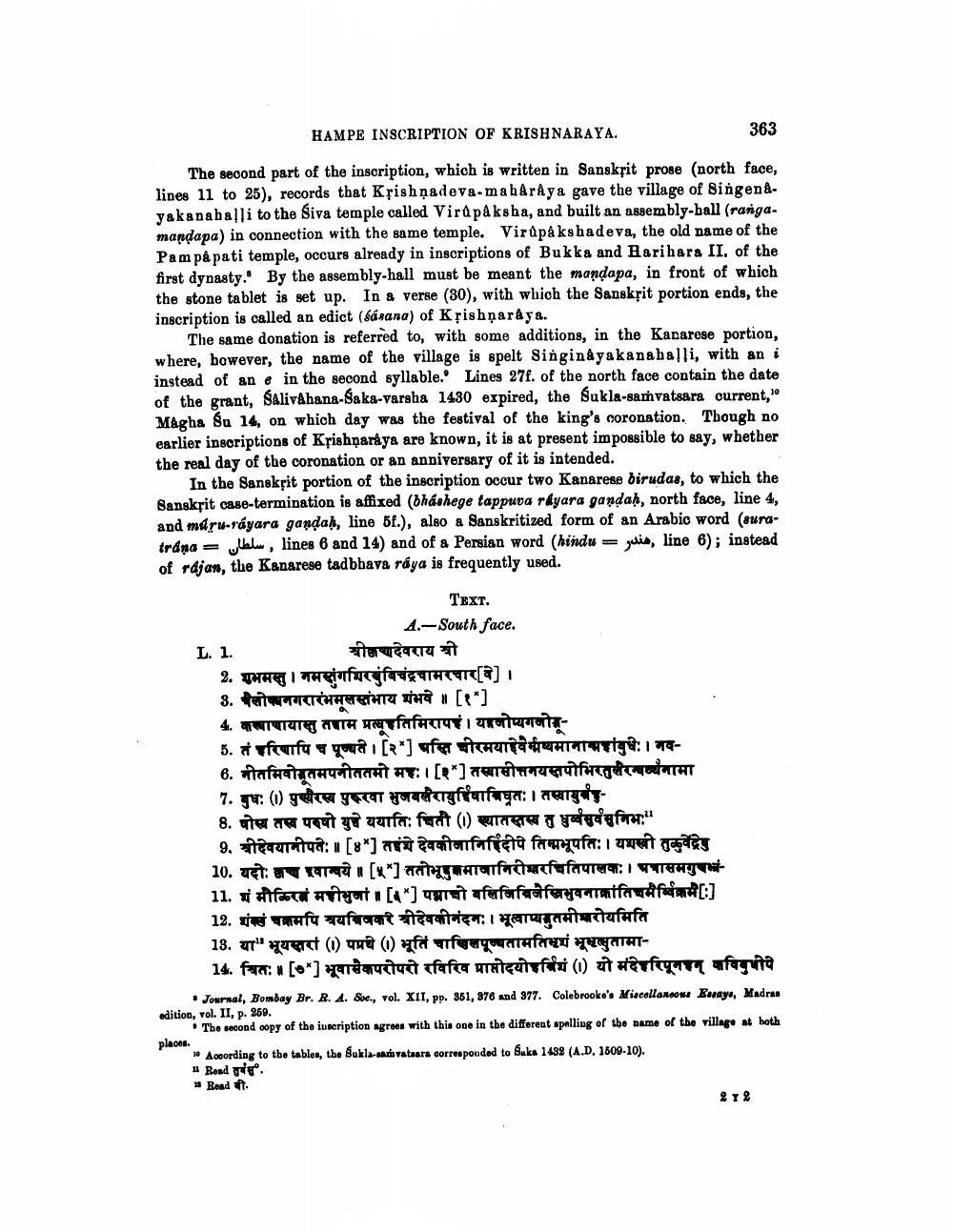________________
HAMPE INSCRIPTION OF KRISHNARAYA.
363
The second part of the inscription, which is written in Sanskrit prose (north face, lines 11 to 25), records that Krishnadeva-mahArAya gave the village of Singenayakanahalli to the siva temple called Virapaksha, and built an assembly-hall (raiga. mandapa) in connection with the same temple. Virupakshadeva, the old name of the Pam på pati temple, occurs already in inscriptions of Bukka and Harihara II. of the first dynasty. By the assembly-hall must be meant the mandapa, in front of which the stone tablet is set up. In a verse (30), with which the Sanskrit portion ends, the inscription is called an edict (6arana) of Krishnaraya.
The same donation is referred to, with some additions, in the Kaparese portion, where, bowever, the name of the village is spelt Singinayakanahalli, with an i instead of an e in the second syllable. Lines 27f. of the north face contain the date of the grant, Salivahana-Saka-Varsha 1430 expired, the Sukla-samvatsara current, Magha Su 14, on which day was the festival of the king's coronation. Though no earlier inscriptions of Krishnaraya are known, it is at present impossible to say, whether the real day of the coronation or an anniversary of it is intended.
In the Sanskpit portion of the inscription occur two Kanarese birudas, to which the Sanskrit case-termination is affixed (bháshege tappuda ráyara gandah, north face, line 4, and muru-ráyara gandah, line 5f.), also a Sanskritized form of an Arabic word (suratrdna = lalu, lines 6 and 14) and of a Persian word (hindu = guia, line 6); instead of rdjan, the Kanarese tadbhava ráya is frequently used.
___TExr.
4.-South face. L.1.
श्रीवच्यादेवराय श्री 2. एभमस्तु । नमस्तुंगभिरविचंद्रचामरचार[वै] । 3. लोक्यनगरारंभमलस्तंभाय शंभवे ॥ [१] 4. कल्याणायास्तु तबाम प्रत्यूहतिमिरापहं। याजोप्यगनोड5. हरिणापि च पूज्यते। [२] पस्ति चीरमयाद्देवैर्मष्यमानामहांबुधः । नव6. नीतमिवोतमपनीततमो महः । [२] तस्वासीत्तनयस्तपोभिरतुसरग्वव्चनामा 7. बुधः (1) पुरस्य पुरुरवा भुजबलरायुर्दिषावितः । तस्यायुगा8. पोख तख परुषो युचे ययाति: चिती (1) स्यातस्तस्य तु धुर्वसुर्वसनिमः॥ 9. श्रीदेवयानीपतेः । [४] तईशे देवकीजानिर्षिदीप तिम्मभूपतिः । यशस्वी तुर्वेदेषु 10. यदोः कण स्वान्वये । [५] ततोभूबमावानिरीश्वरक्षितिपालकः । पत्रासमगुष11. मौकिरवं महीभुजा [] पनाचो बलिजिबिजेत्रिभुवनाक्रांतिवमैविक्रमः] 12. शंक्वं चक्रमपि वयचिवकर श्रीदेवकीनंदनः । भूत्वाप्यनुतमीबरोयमिति 18. या" भूयस्तरा (1) पप्रथे (1) भूतिं चाविसपूच्चतामतिमयं भूभमुतामा
14. चितः । [*] भूवासैकपरोपरी रविरिव प्राप्तोदयोहर्षि (१) यो मंदेहरिपूनान् कविबुधोपे • Journal, Bombay Br. R. 4. Soc., vol. XII, pp. 361, 378 and 377. Colebrooke's Miscellaneous Euaye, Madras edition, vol. II, p. 269.
• The second copy of the iuscription agrees with this one in the different spelling of the name of the village at both places.
WAccording to the tables, the Bukla-satirataara corresponded to Buka 1492 (A.D. 1500-10). I Rend तु .
Read it.




